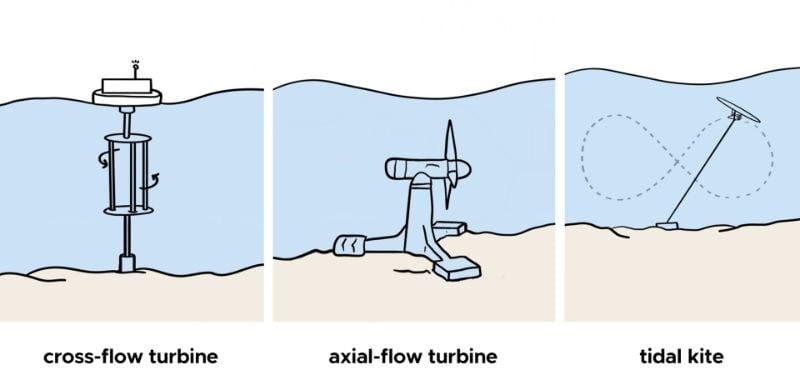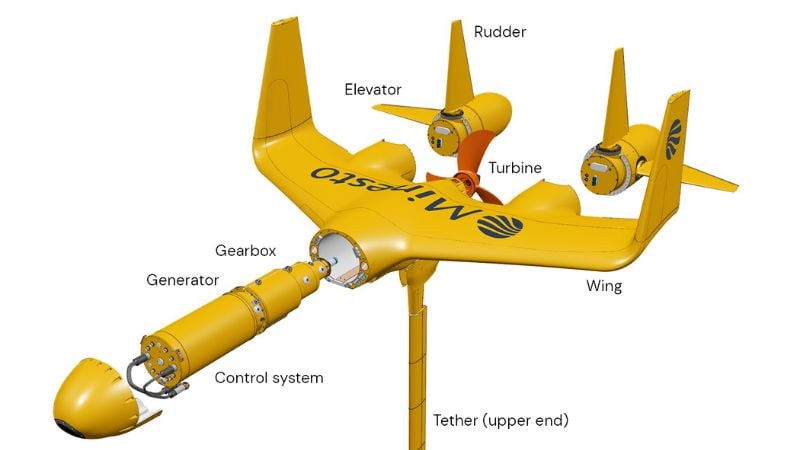Minesto’s Tidal Kite Sends Megawatts to Island Grid
Minesto's Dragon 12 enables seamless megawatt-scale tidal energy generation in the Faroe Islands.
Amidst escalating global energy needs, a blend of conventional and renewable sources has been instrumental in meeting the growing demand for sustainable energy solutions and mitigating environmental impact. However, not all renewable energy sources are consistent and reliable. Tidal energy has emerged as a dependable, uninterrupted energy source in efforts to address climate change.
Until now, tidal energy has largely been underutilized, but recently, Minesto commissioned its first megawatt-scale tidal kite power plant in the Faroe Islands in the North Atlantic Ocean. How can Minesto’s tidal kite powerplant address the challenges of implementing non-intermittent renewable energy sources?
Installation of Minesto’s Dragon kite. Image used courtesy of Minesto
Tidal Energy Generation
Solar and wind energy, as renewable sources, generate power inconsistently due to factors like weather conditions. Non-intermittent sources like tidal and geothermal energy provide a consistent and dependable power supply unaffected by external factors, rendering them ideal for baseload power generation.
Tidal energy harvesting involves capturing energy from the movement of ocean tides to produce electricity. A specific type of tidal project is a tidal barrage, which utilizes barriers or dams equipped with turbines to harness tidal energy. These projects require expensive, durable turbines and typically cost millions of dollars. In the U.K., these systems generate electricity at a rate of £178 ($216) per megawatt-hour (MWh), significantly higher than the £65 ($79) per MWh generated by offshore wind projects. This high cost has been a notable barrier to entry for tidal energy growth.
Types of tidal energy devices. Image used courtesy of Pacific Northwest National Laboratory
One promising form of tidal energy harvesting is a tidal kite, which features a hydrodynamic wing with an attached turbine. The kite maneuvers in a figure-eight pattern within the tidal stream. It is tethered to a fixed point and is neutrally buoyant, ensuring stability during changing tides. The turbine generates electricity as it spins faster in stronger oceanic currents, transferring power via a cable connected to the tether.
Compared to traditional turbines, the kite-shaped design captures energy from the moving water over a larger area, resulting in increased power generation. Additionally, the flexible nature of the kite allows it to adapt to changing tidal conditions, optimizing energy extraction.
Minesto’s Underwater Kite Starts Generating Energy
In a milestone achievement, Minesto's first megawatt-scale tidal power plant went through a seamless integration into the national grid of the Faroe Islands.
Minesto’s Dragon 12, a 1.2 MW tidal kite with an 8-shaped flight path, measuring 12 meters wide and weighing 28 tons, is anchored with a rope to harness tidal flows for electricity generation. It uses a sophisticated onboard control system and rudders to guide the kite in an intricate figure-eight path. As it maneuvers, water is channeled through the turbine within the system, facilitating electricity generation.
Minesto's team meticulously designed and tested the Dragon 12 power plant, incorporating advanced Launch and Recovery System (LARS) procedures for safe and effective deployment and retrieval. The scalability of the Dragon 12, a tenfold increase in size from its predecessor, Dragon 4 (100 kW capacity), necessitated rigorous testing and adaptation of the LARS method, ensuring its compatibility with the larger model.
Minesto Dragon 12 tidal power plant. Image used courtesy of Minesto
Research indicates technologies like Minesto’s can operate in conditions with mean peak velocities of about 1.5 m/s at depths surpassing 50 meters. According to Minesto, its device amplifies the energy extraction potential from tidal streams by a factor of 35. Additionally, it is lightweight, modular, scalable, and offers increased speed (relative to water). This reduces the size of the rotor compared to stationary turbines, making it a more cost-effective option.
Video used courtesy of Minesto
According to Minesto, Dragon 12's competitive performance and cost efficiency pave the way for establishing extensive commercial subsea parks for tidal power plants.
Powering the Future of Renewable Energy
From the successful installation and activation of the inaugural Dragon Class power plant in 2022 to the recent commissioning of Dragon 12 on February 12, Minesto has made significant strides in transforming the future of marine energy. The recent innovation demonstrates the potential of tidal energy and paves the way for developing large-scale commercial subsea parks of tidal power plants.









